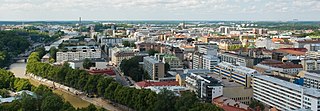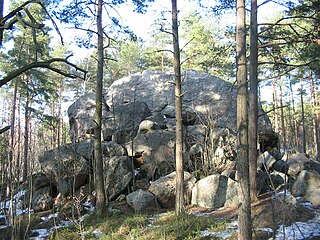
Turku is a city and former capital on the southwestern coast of Finland at the mouth of the River Aura, in the region of Southwest Finland (Varsinais-Suomi) and the former Turku and Pori Province. The region was originally called Suomi (Finland), which later became the name of the whole country. The population of Turku is 201,889, making it the sixth largest city in Finland. The Turku region has a population of 346,662, making it the third largest urban area in Finland after the Helsinki and Tampere regions. The city is officially bilingual, with 5.5 per cent of the population having Swedish as their mother tongue.

Mikael Agricola was a Finnish Lutheran clergyman who became the de facto founder of literary Finnish and a prominent proponent of the Protestant Reformation in Sweden, including Finland, which was a Swedish territory at the time. He is often called the "father of literary Finnish".

Henry was a medieval English clergyman. He came to Sweden with Cardinal Nicholas Breakspeare in 1153 and was most likely designated to be the new Archbishop of Uppsala, but the independent church province of Sweden could only be established in 1164 after the civil war, and Henry would have been sent to organize the Church in Finland, where Christians had already existed for two centuries.
The Islands of Turku consist of islands belonging to the Finnish city of Turku. There are dozens of islands and skerries, of which four have significant amounts of permanent inhabitants:

Ruisrock is a rock festival held annually on the island of Ruissalo in Turku, Finland. Ruisrock, founded in 1970, is the second oldest rock festival in Europe and the oldest in Finland. The festival has attracted international artists throughout its lifetime except around the start of the 2000s (decade), due to the organiser's economic issues.

The University of Turku is a multidisciplinary public university with eight faculties located in the city of Turku in southwestern Finland. The university also has campuses in Rauma and Pori and research stations in Kevo and Själö.

Turku Cathedral is the only medieval basilica in Finland and the Mother Church of the Evangelical Lutheran Church of Finland. It is the central church of the Lutheran Archdiocese of Turku and the seat of the Lutheran Archbishop of Finland, Tapio Luoma. It is also regarded as one of the major records of Finnish architectural history.

Ruissalo is an island in the Archipelago Sea and a district of the city of Turku, Finland. The island is located to the south-west of the city, between Hirvensalo and Pansio in the mainland. It is rather sparsely populated, having a population of only 126, with an annual growth rate of 3.97%. The villas on the island are considered culturally and historically valuable in Finland. Some are used as guesthouses; some are owned and run by foundations, labor unions, sports teams, and private enterprises in the area; some can be rented freely for days for private parties such as weddings; some have cafeterias in them. Private ownership exists – a couple villas even have renters with very selective occupancy. Some villas have deteriorated because of the high maintenance costs due to the historical building methods that must be used here.
The city of Turku, Finland is divided into nine wards, which in turn are divided into 78 non-governmental districts. These are composed of individual suburbs, and in the very centre of the city, sectors of the central business district are identified by Roman numerals. This is a list of the districts in Turku in alphabetical order, grouped by wards.
This is a list of the districts of Turku, Finland, sorted by population as of 2004.
- Runosmäki (Runosbacken), 10,269
- Varissuo (Kråkkärret), 8,760
- VII, 8,749
- Nummi (Nummis), 7,011
- VI, 6,187
- I, 6,177
- VIII - Port Arthur, 4,760
- Pääskyvuori (Svalberga), 4,482
- Luolavuori, 4,477
- Pahaniemi, 4,397
- IV - Martti (Martins), 4,357
- Vasaramäki (Hammarbacka), 3,949
- Harittu, 3,870
- V - Itäranta (Öststranden), 3,677
- Uittamo, 3,635
- Teräsrautela, 3,554
- Halinen (Hallis), 3,501
- Jäkärlä, 3,460
- Lauste (Laustis), 3,405
- III, 3,222
- Vätti, 2,990
- Kurala, 2,956
- Itäharju (Österås), 2,940
- II, 2,919
- Pansio, 2,905
- Ilpoinen (Ilpois), 2,889
- Pitkämäki (Långbacka), 2,886
- Perno, 2,513
- Paattinen (Patis), 2,430
- Ruohonpää, 2,375
- Yli-Maaria (Övre S:t Marie), 2,209
- Kaerla, 2,182
- Kärsämäki, 2,021
- Kastu, 2,002
- Räntämäki, 1,924
- Iso-Heikkilä (Storheikkilä), 1,905
- Moikoinen (Moikois), 1,880
- Koivula (Björkas), 1,761
- Mälikkälä, 1,608
- Pohjola (Norrstan), 1,569
- Mäntymäki (Tallbacka), 1,489
- Kukola, 1,486
- Raunistula, 1,442
- IX - Länsiranta (Väststranden), 1,386
- Haarla (Harlax), 1,316
- Katariina (Katarina), 1,282
- Kohmo, 1,223
- Vähäheikkilä (Lillheikkilä), 1,153
- Pihlajaniemi (Rönnudden), 1,139
- Huhkola, 986
- Vaala (Svalas), 972
- Kähäri, 934
- Peltola, 778
- Satava, 764
- Puistomäki (Parkbacken), 734
- Kurjenmäki (Tranbacken), 679
- Kakskerta, 633
- Kaistarniemi (Kaistarudden), 630
- Saramäki (Starbacka), 530
- Ispoinen (Ispois), 480
- Korppolaismäki (Korppolaisbacken), 349
- Lauttaranta (Färjstranden), 236
- Pikisaari (Beckholmen), 226
- Oriniemi, 161
- Papinsaari, 158
- Skanssi (Skansen), 141
- Turku Airport (Turun lentoasema / Åbo flygstation), 127
- Ruissalo (Runsala), 126
- Oriketo, 120
- Särkilahti, 111
- Maanpää, 107
- Toijainen (Toijais), 102
- Illoinen (Illois), 85
- Artukainen (Artukais), 78
- Port of Turku (Turun satama / Åbo hamn), 44
- Jänessaari, 26
- Koroinen (Korois), 26
- Friskala, 23
- Kupittaa (Kuppis), 9

Naantalintie is a ward of Turku, Finland, also known as Ward 8. The ward is located to the west of the city and named after the major route that passes through the ward in the direction of Naantali. The ward also includes the island of Ruissalo.
The Archdiocese of Turku, historically known as Archdiocese of Åbo, is the seat of the Archbishop of Turku. It is a part of the Evangelical Lutheran Church of Finland, and its see city is Turku.

The R-class patrol boats was a class of Finnish patrol boats, originally constructed as coastal minesweepers. They were modified into patrol boats by the end of the 1960s and transferred to the Patrol Flotilla and later to the 7th Missile Flotilla. They were then used for sea patrol and as anti-submarine warfare vessels. They were stricken from the Finnish Navy list in the 1990s. The three later vessels, Ruissalo, Raisio and Röyttä, were somewhat larger and the vessels are therefore sometimes referred to as the Rihtniemi and Ruissalo classes. However, the Finnish Navy used the designation R class for all five vessels.

The Paavo Nurmi Marathon is an annual marathon road running race held during summer in Turku, Finland, the birth city of Paavo Nurmi. Although various marathons have been held in Turku since 1910, the Paavo Nurmi Marathon was established in 1992. It is arranged along with Paavo Nurmi Games, a part of Paavo Nurmi happening week. The route goes through Turku city and Ruissalo park. The marathon attracts yearly 500 to 1000 participants.
The Battle of Rimito Kramp was fought between Sweden and Russia during the Finnish War 1808–09.

Vartiovene 55 is a former Finnish Navy R-class patrol boat bought into private ownership and converted into a commercial cruise ship. It can be rented for private pleasure trips on the Baltic Sea.
Harry Kivijärvi (1931-2010) was a sculptor from Finland.
The following is a list of notable events and releases of the year 2017 in Finnish music.

Pallivahankivi is a 10 meter tall glacially deposited rock that is located in the region of Pallivaha. The region of Pallivaha is named after the rock. The rock is associated with a Finnish folkstory, according to the legend, the rock was thrown into its current place by giants from the region of Nunnavuori. Later legends say that the rock became a shelter for criminals who lived in the area.
Church Builders Killi and Nalli is a public sculpture in Raisio, Finland. Created by the sculptor Harry Kivijärvi in red granite, it stands in the park area between Raisio City Hall and the Church of St. Martin.













